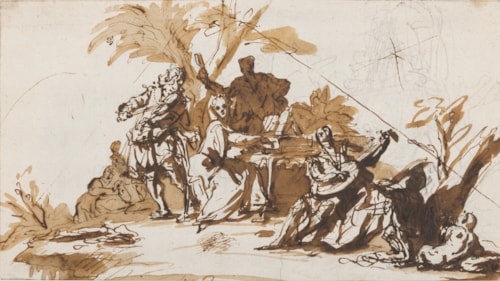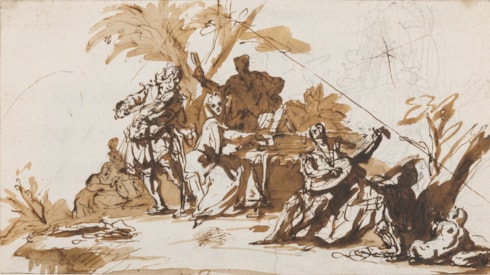
Gregorio GUGLIELMI
Rome 1714 - St. Petersburg 1773
Biography
A pupil of Francesco Trevisani in Rome, Gregorio Guglielmi also came under the influence of the painters Marco Benefial, Sebastiano Conca and Corrado Giaquinto. According to his biographer Luigi Lanzi, Guglielmi’s fresco decorations were greatly admired, and it is as a frescante that he first made his mark in Rome, where he is recorded by the end of the 1730s. Among his important Roman projects were frescoes in the churches of Santo Spirito, executed in 1742, and Santa Trinità, painted between 1746 and 1749, as well as a Time Revealing Truth for the Biblioteca Corsiniana and frescoes for the hospital of Santo Spirito in Sassia. In 1748 he was admitted to the Accademia di San Luca. As early as 1739 Guglielmi had painted an altarpiece for a church in Prague, and by the middle of the century he had begun to travel extensively outside Italy, establishing a reputation as one of the finest decorative painters in Europe.
Between 1754 and 1755 he was in Vienna, where he painted an allegorical ceiling fresco of The Arts and Sciences at the Alte Universität. The success of this project led to a commission from the Empress Maria Theresa for what was to be one of his most famous works; the vibrant ceiling frescoes in the Hapsburg summer palace of Schloss Schönbrunn, near Vienna, painted between 1759 and 1761. After some years in Berlin, Guglielmi was in Turin from 1765, working at the Palazzo Chiablese, the church of the Santi Martiri and the Palazzo Reale, for which he painted a ceiling fresco of the Four Corners of the World. Guglielmi was also active in Naples, Dresden, Bergamo, Stuttgart, Augsburg, Warsaw, Munich and St. Petersburg, where he died in 1773.


